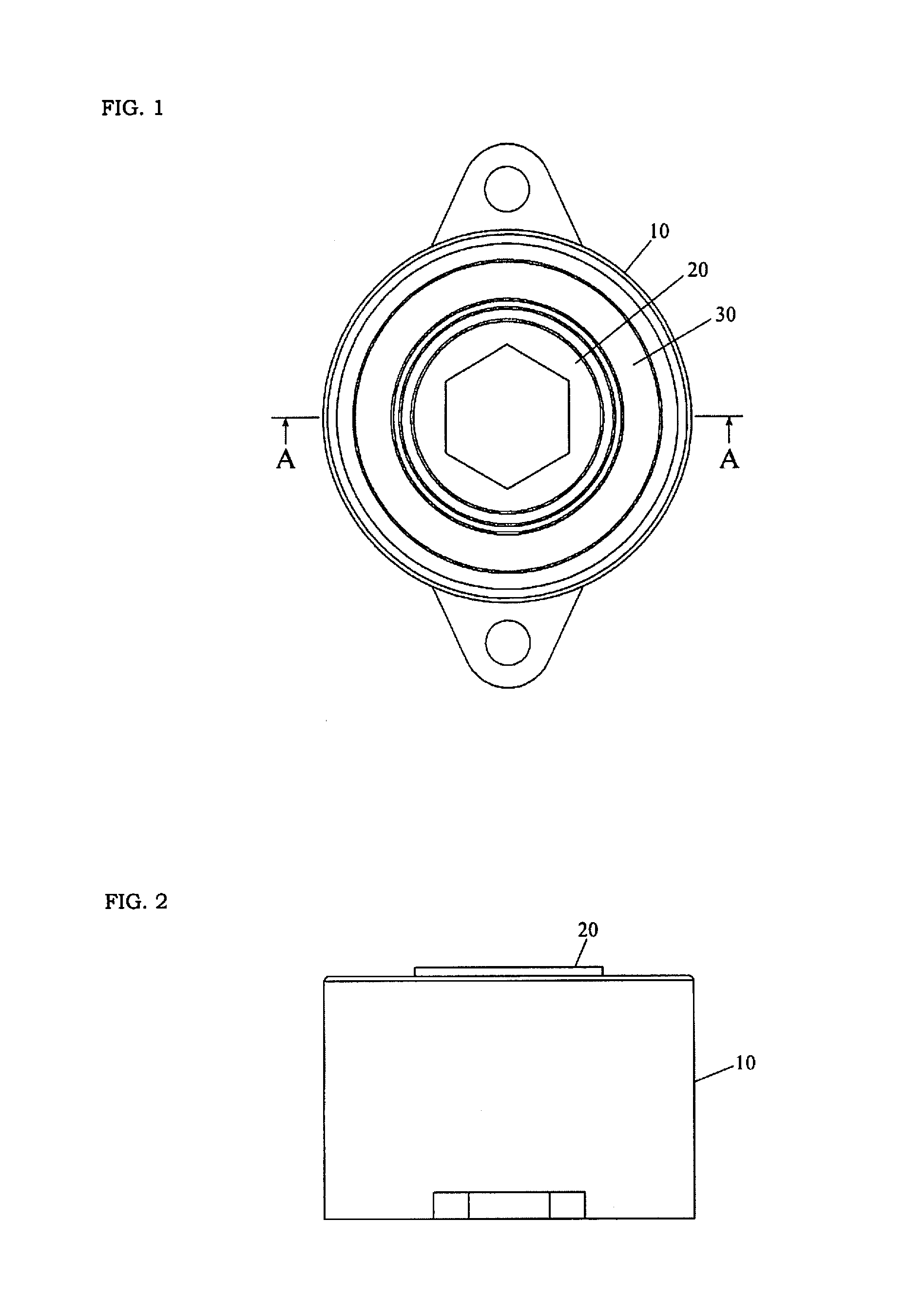Rotary Damper
- Summary
- Abstract
- Description
- Claims
- Application Information
AI Technical Summary
Benefits of technology
Problems solved by technology
Method used
Image
Examples
first embodiment
[0038]FIGS. 1 to 4 illustrate a rotary damper according to a first embodiment of the invention. As illustrated in these figures, the rotary damper according to the first embodiment includes a housing 10, a shaft 20, a plug 30, partitions 40, a viscous liquid and vanes.
[0039]The housing 10 is open at its one end, and is completely closed at the other end by an end wall 11 (see FIG. 3). The housing 10 has a cylindrical peripheral wall 12 integral with the end wall 11, and is hollow (see FIGS. 3 and 4). The end wall 11 has a bearing 13 (see FIG. 3). The end wall 11 completely closes the other end of the housing 10, and therefore an aperture extending through the end wall 11 cannot be employed as a bearing formed in the end wall 11. The bearing 13 in the first embodiment has a convex form, but may have a concave form.
[0040]The shaft 20 has a concavity fitted to the bearing 13 (see FIG. 3). When the bearing formed in the end wall 11 has a concave form, a shaft having a convexity fitted t...
second embodiment
[0047]A rotary damper according to the second embodiment differs from the rotary damper according to the first embodiment in structures of vanes and a valve body 84. More specifically, the vane of the second embodiment includes first and second pressurizing portions 51 and 52 similarly to the vanes of the first embodiment, but the first pressurizing portion 51 is axially longer than the second pressurizing portion 52 (see FIGS. 9 and 10). However, the axial length of the first pressurizing portion 51 is determined such that the first pressurizing portion 51 may not come into contact with a plug 30 during rotation of a housing 10 or a shaft 20.
[0048]Similarly to the valve body 84 of the first embodiment, the valve body 84 includes a stop 84c arranged between the plug 30 and the second pressurizing portion 52, but does not have a portion arranged between the plug 30 and the first pressurizing portion 51 (see FIGS. 9 and 10). FIG. 9 illustrates an arrangement of the valve body 84 in an...
third embodiment
[0052]A rotary damper according to the third embodiment differs in a structure of a valve body 84 from the rotary damper according to the first embodiment. The valve body 84 of the third embodiment further includes a stop 84d made of resin and arranged between an end wall 11 and vanes (first and second pressurizing portions 51 and 52) (see FIGS. 11 and 12).
[0053]An experiment was performed using the rotary damper according to the third embodiment and a rotary damper according to a comparative example. The rotary damper according to the comparative example does not have stops 84c and 84d, and is different in this structure from the rotary damper of the third embodiment.
[0054]In this experiment, a shaft was rotated by 60 degrees from an initial position in a braking force generating direction, and this rotation was repeated 30,000 times with a housing kept in a fixed state. A load applied to the shaft was 14 Nm, and plugs and vanes in both the third embodiment and the comparative exam...
PUM
 Login to View More
Login to View More Abstract
Description
Claims
Application Information
 Login to View More
Login to View More - R&D
- Intellectual Property
- Life Sciences
- Materials
- Tech Scout
- Unparalleled Data Quality
- Higher Quality Content
- 60% Fewer Hallucinations
Browse by: Latest US Patents, China's latest patents, Technical Efficacy Thesaurus, Application Domain, Technology Topic, Popular Technical Reports.
© 2025 PatSnap. All rights reserved.Legal|Privacy policy|Modern Slavery Act Transparency Statement|Sitemap|About US| Contact US: help@patsnap.com



